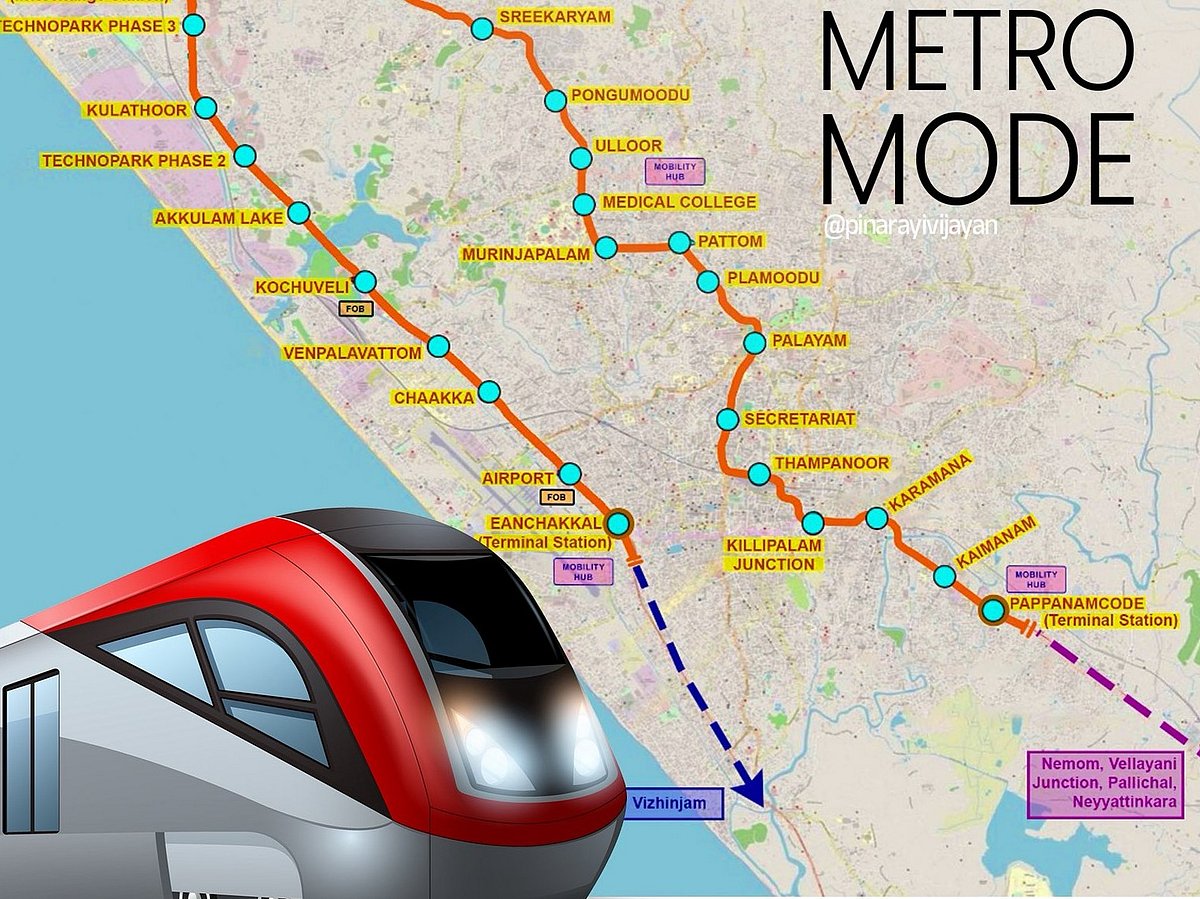Thiruvananthapuram Metro Project First Phase Approved
The Thiruvananthapuram Metro Rail project has taken a significant step forward with the approval of its first phase by Kerala Chief Minister Pinarayi Vijayan. This development marks a crucial milestone in enhancing urban transportation in the state capital, aiming to improve connectivity and support the region’s growth.
Project Overview
The first phase of the Thiruvananthapuram Metro will span 31 kilometers and feature 27 stations. This route is strategically designed to connect vital locations, including all three phases of Technopark, Thiruvananthapuram International Airport, the Thampanoor KSRTC bus stand, the railway station, the Secretariat, and the Government Medical College Hospital.
Key interchange stations will be established at Kazhakkoottam, Technopark, and Kariavattom, facilitating smooth transitions for commuters. The metro line will commence at Pappanamcode and traverse through several important areas, including Killippalam, Palayam, Sreekariyam, Kazhakkoottam, Technopark, Kochuveli, and the airport, concluding at Enchakkal.
Construction and Development Plans
Kochi Metro Rail Ltd (KMRL) has been designated to implement the project. As part of the preparatory work, KMRL is also tasked with constructing flyovers at Sreekariyam, Ulloor, and Pattom, with the Sreekariyam flyover reportedly progressing swiftly.
The Chief Minister emphasized that the metro project is expected to significantly boost infrastructure development and urban growth in Thiruvananthapuram. In accordance with the Metro Rail Policy of 2017 and central government guidelines, the Transport Department has directed KMRL to prepare and submit a Detailed Project Report (DPR) based on the approved alignment.
Historical Context
The initiative for light metro systems in Thiruvananthapuram and Kozhikode received administrative sanction back in September 2015. The project was subsequently handed over to KMRL in September 2022, which included the development of the Comprehensive Mobility Plan (CMP), Alternative Analysis Report (AAR), and a revised DPR.
A thorough mobility study conducted by KMRL concluded that a conventional metro system would be the most effective solution to accommodate the city’s growing population, surpassing the capabilities of a Mono Rail or Light Metro.
FAQs
What are the key features of the Thiruvananthapuram Metro project?
The project includes a 31-kilometer route with 27 stations, connecting major hubs such as Technopark, the airport, and the railway station.
Who is responsible for implementing the metro project?
Kochi Metro Rail Ltd (KMRL) has been assigned the implementation of the Thiruvananthapuram Metro project.
When was the initial approval for the metro system granted?
Administrative sanction for the light metro systems in Thiruvananthapuram and Kozhikode was first granted in September 2015.
Conclusion
The approval of the first phase of the Thiruvananthapuram Metro project represents a significant advancement in urban infrastructure for the city. With KMRL now tasked with detailed planning and construction, the project is poised to enhance connectivity and support the region’s growth in the coming years.
The Thiruvananthapuram Metro project is part of a broader initiative to modernize urban transportation across India, where several cities are investing in metro systems to alleviate traffic congestion and promote sustainable transit options. The Kerala government has recognized the need for improved public transport solutions, particularly in rapidly urbanizing areas like Thiruvananthapuram, where population growth and increased vehicular traffic have led to significant challenges in mobility.
The project is expected to not only enhance daily commuting for residents but also stimulate economic activities by improving access to key commercial and administrative centers. The integration of the metro with existing transportation networks, such as buses and trains, is crucial for maximizing its utility and ensuring seamless travel for users. As the project progresses, it will likely involve extensive community engagement to address concerns and gather feedback from local stakeholders, which is essential for fostering public support and ensuring the project’s success.
Furthermore, the implementation of the Thiruvananthapuram Metro aligns with the Indian government’s push for smart city initiatives, which aim to create sustainable urban environments through advanced infrastructure and technology. As cities across the country adopt similar projects, the outcomes of the Thiruvananthapuram Metro could serve as a valuable case study for future urban transport developments in other regions.
Also Read:
Expo City Dubai: Transforming into a Sustainable Urban Hub







